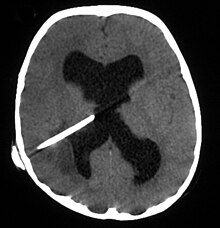Signs and Symptoms
- Fever, headache, and neurological problems occur in 20% of people with brain abscess
- The famous triad of fever, headache, and focal neurologic findings are highly suggestive of brain abscess
- Headache is characteristically worse at night and in the morning
- Other symptoms depend on the specific location of the abscess in the brain
- Neurological examination may reveal a stiff neck in occasional cases
Pathophysiology
- Anaerobic and microaerophilic cocci and gram-negative and gram-positive anaerobic bacilli are the predominant bacterial isolates
- Staphylococcus aureus, streptococci, Bacteroides, Prevotella, and Fusobacterium are the predominant organisms
- Less common organisms include Haemophillus influenzae, Streptococcus pneumoniae, and Neisseria meningitidis
- Fungi and parasites may also cause brain abscess, especially in immunocompromised patients
- Other causes include Nocardia asteroides, Mycobacterium, Aspergillus, Candida, and Cryptococcus
- Predisposing conditions include sinus and dental infections, penetrating trauma, pulmonary infections, congenital heart disease, HIV infection, transplantation, and neutropenia
Diagnosis
- The diagnosis is established by a computed tomography (CT) examination
- The immature lesion may be difficult to distinguish from other space-occupying lesions or infarcts of the brain
- Within 4-5 days, the inflammation and dead brain tissue are surrounded with a capsule, giving the lesion a ring-enhancing appearance on CT with contrast
- Lumbar puncture is contraindicated in brain abscess
- Ring enhancement may also be observed in cerebral hemorrhages and some brain tumors, but the presence of fever, focal neurologic findings, and signs of increased intracranial pressure suggest brain abscess
Treatment
- Treatment includes lowering intracranial pressure and starting intravenous antibiotics
- Hyperbaric oxygen therapy (HBOT) reduces intracranial pressure, acts as a bactericide, optimizes immune function, and aids in healing and recovery
- Surgical drainage of the abscess is part of the standard management
- Treatment of the primary lesion and removal of foreign material are crucial
- Exceptions to surgical drainage include Haemophilus influenzae meningitis and tuberculosis
Prognosis and Complications
- Death occurs in about 10% of cases
- People do well about 70% of the time
- Improved ability to image the head has contributed to better prognosis
- More effective neurosurgery has improved outcomes
- More effective antibiotics have also played a role in improving prognosis
- Neurological deficits can occur as a result of brain abscess
- Infection can spread to surrounding structures, such as the meninges
- Abscess rupture can lead to meningitis
- Increased intracranial pressure is a potential complication
- Long-term cognitive and functional impairments may occur in some cases
Prevention
- Prompt treatment of sinusitis and other infections can help prevent brain abscess
- Proper wound care and infection control measures are important
- Vaccination against certain bacterial pathogens can reduce the risk of brain abscess
- Avoiding high-risk behaviors, such as intravenous drug use, can lower the risk
- Regular dental care and oral hygiene can help prevent dental infections that can lead to brain abscess
Brain abscess (or cerebral abscess) is an abscess within the brain tissue caused by inflammation and collection of infected material coming from local (ear infection, dental abscess, infection of paranasal sinuses, infection of the mastoid air cells of the temporal bone, epidural abscess) or remote (lung, heart, kidney etc.) infectious sources. The infection may also be introduced through a skull fracture following a head trauma or surgical procedures. Brain abscess is usually associated with congenital heart disease in young children. It may occur at any age but is most frequent in the third decade of life.
| Brain abscess | |
|---|---|
 | |
| Brain abscess in a person with a CSF shunt. The abscess is the darker gray region in the lower left of the image (corresponding to the right parietal lobe). The lateral ventricles are visible in black in the center of the brain, adjacent to the abscess. | |
| Specialty | Neurology, infectious diseases |